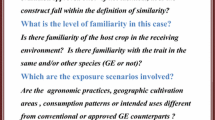Abstract
The safe application of genetically modified organisms (GMOs) requires a risk assessment prior to their proposed use. Based on methods from the chemical industry, we developed a hazard identification procedure for the risk assessment of field tests with genetically modified plants. This risk assessment method, GMHAZID, is carried out in the form of guided brainstorm sessions. GMHAZID was tested with a case study for which a risk assessment had previously been made, and the results of the assessments were compared. The results showed that some new hazards potentially leading to uncontrolled spreading, in addition to those from the previous assessment, were identified using GMHAZID. GMHAZID also recognised some hazards leading to failures in the field experiments. We suggest that GMHAZID provides systematics, reliability, and transparency to the risk assessment procedure.
Similar content being viewed by others
References
Conway G, Toenniessen G (1999): Feeding the world in the twentyfirst century. Nature 402, Suppl. C55-C58
Ewen SW, Pusztai A (1999): Effect of diets containing genetically modified potatoes expressingGalanthus nivalis lectin on rat small intestine. Lancet 354: 1353–1354
Gilissen LJ, Metz PL, Stiekema WJ, Nap JP (1998): Biosafety ofE. coli betaglucuronidase in plants. Transgenic Res 7: 157–163
Guidelines for Hazard Evaluation Procedures (1992): Second Edition with Worked Examples. Center for Chemical Process Safety, New York, 461 pp
Hillbeck A, Baumgartner M, Fried PM, Bigler F (1998): Effects of transgenicBacillus thuringensis corn-fed prey on mortality and development time of immatureChrysoperla carnea (Neuroptera: Chrysopidae). Environ Entom 27: 480–487
James C (1997): Global status of transgenic crops in 1997. ISAAA Briefs No 5. ISAAA, Ithaca, New York
Jank B, Haymerle H, Doblhoff-Dier O (1996): Zurich hazard analysis in biotechnology. Nature Biotechnology 14 (7): 894–896
Kjellsson G, Simonsen V (1994): Methods for risk assessment of transgenic plants I. Birkhäuser Verlag 1994. 214 pp
Losey JE, Rayor LS, Carter ME (1999): Transgenic pollen harms monarch larvae. Nature 399: 214
Scientists’ Working Group on Biosafety (1998): Manual for assessing ecological and human health effects of genetically engineered organisms. Parts I and II. The Edmonds Institute. 158 and 245 pp
Martens MA (2000): Safety evaluation of genetically modified foods. Int Arch Occup Environ Health 73 (Suppl 1): S14-S18
Nakamura R, Matsuda T (1996): Rice allergenic protein and molecular-genetic approach for hypoallergenic rice. Biosci Biotechnol Biochem 60 (8): 1215–21
Rao VR, Iwanaga M (1997): Utilization of Plant Genetic Resources. In: Plant Biotechnology and Plant Genetic Resources for Sustainability and Productivity. Eds Watanabe KN and Pehu E. Academic Press, Austin, pp 26–69
Saxena D, Flores S, Stotzky G (1999): Insecticidal toxin in root exudates from Bt corn. Nature 402: 480
Suokas J (1994): Plant level hazard identification based on functional models. International Conference on Probabilistic Safety Assessment and Management. San Diego, 20–25 March 1994. San Diego, 1994. 12 pp
Watkinson AR, Freckleton RP, Robinson RA, Sutherland WJ (2000): Predictions of biodiversity response to genetically modified herbicide tolerant crops. Science 289: 1554–1557
Winding A, Kvaløy K, Hendriksen NB., Gustafsson K, Iversen TG, Helgason E, Kolstø A-B (1998): Procedures for risk identification and assessment of genetically modified microorganisms. Nordtest report 381. 60 pp
Ye X, Al-Babili S, Kloti A, Zhang J, Lucca P, Beyer P, Potrykus I (2000): Engineering the provitamin A (beta-carotene) biosynthetic pathway into (carotenoid-free) rice endosperm. Science 287 (5451): 303–305
Author information
Authors and Affiliations
Corresponding author
Rights and permissions
About this article
Cite this article
Koivisto, R.A., Törmäkangas, K.M. & Kauppinen, V.S. Hazard identification and risk assessment procedure for genetically modified plants in the field—GMHAZID. Environ Sci & Pollut Res 9, 110–116 (2002). https://doi.org/10.1007/BF02987457
Received:
Accepted:
Issue Date:
DOI: https://doi.org/10.1007/BF02987457




